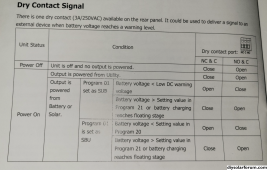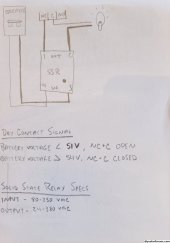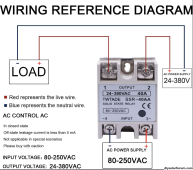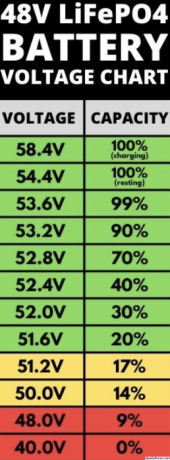You are using an out of date browser. It may not display this or other websites correctly.
You should upgrade or use an alternative browser.
You should upgrade or use an alternative browser.
Using Grid Back-Feed Capability for Water Heater Dump Load
- Thread starter SunFarmer
- Start date
David in nh
dreaming of 48 volts
- Joined
- Oct 18, 2019
- Messages
- 129
at this point this is a simple preheater from here it would go though wood boiler then oil burner if more heat is needed for final usage
David in nh
dreaming of 48 volts
- Joined
- Oct 18, 2019
- Messages
- 129
maybe not the most efficient , but other wise that amount of power would have been wasted that is 4500 watts of solar panels that was just hanging out doing nothing in this case
This is a bit niche but I programmed an Arduino to poll the serial port of my easun inverter.
The Arduino can obtain all the operating voltages/currents etc since 1 second ago.
The program monitors the PV array voltage to ensure it is high enough. Then it gently loads the inverter to test if there is any spare energy to divert to a 1.2 kw hot tank element.
Whenever the generated PV watts exceeds the inverter output watts by 30 watts the Arduino begins to increase the firing angle of a triac connected to the hot tank heater element.
As long as the battery remains charging or is fully charged the Arduino keeps diverting power to the heater.
This way the hot tank is boiling hot by about noon on a decent sunny day.
There are a number of critical parameters that drive the Arduino logic but it works well. As a bonus I can display how many kwh were used per day and how much solar kwh was generated.
There is also a long term watt meter display that can log up to 9999 kwh.
next step is to log all this to an openlog based SD card data logger. Or run a raspberry Pi/ Banana Pi data logger.
The Arduino can obtain all the operating voltages/currents etc since 1 second ago.
The program monitors the PV array voltage to ensure it is high enough. Then it gently loads the inverter to test if there is any spare energy to divert to a 1.2 kw hot tank element.
Whenever the generated PV watts exceeds the inverter output watts by 30 watts the Arduino begins to increase the firing angle of a triac connected to the hot tank heater element.
As long as the battery remains charging or is fully charged the Arduino keeps diverting power to the heater.
This way the hot tank is boiling hot by about noon on a decent sunny day.
There are a number of critical parameters that drive the Arduino logic but it works well. As a bonus I can display how many kwh were used per day and how much solar kwh was generated.
There is also a long term watt meter display that can log up to 9999 kwh.
next step is to log all this to an openlog based SD card data logger. Or run a raspberry Pi/ Banana Pi data logger.
JHovel
New Member
Would you please go into a bit more details - or even show the code? You have just outlined EXACTLY what I would like to do with our hot water tank, but I donlt really know how. I have some arduinos and some electrocnic skills - just not enough to pull this off by myself safely.This is a bit niche but I programmed an Arduino to poll the serial port of my easun inverter.
The Arduino can obtain all the operating voltages/currents etc since 1 second ago.
The program monitors the PV array voltage to ensure it is high enough. Then it gently loads the inverter to test if there is any spare energy to divert to a 1.2 kw hot tank element.
Whenever the generated PV watts exceeds the inverter output watts by 30 watts the Arduino begins to increase the firing angle of a triac connected to the hot tank heater element.
As long as the battery remains charging or is fully charged the Arduino keeps diverting power to the heater.
This way the hot tank is boiling hot by about noon on a decent sunny day.
There are a number of critical parameters that drive the Arduino logic but it works well. As a bonus I can display how many kwh were used per day and how much solar kwh was generated.
There is also a long term watt meter display that can log up to 9999 kwh.
next step is to log all this to an openlog based SD card data logger. Or run a raspberry Pi/ Banana Pi data logger.
The code I wrote is specific to Easun and uses their own serial communication protocols.
I realized how dangerous it can be to try and read voltages from the PV array, the AC from the inverter and the battery voltage while maintaining isolation between the three.
So I ripped the readings from the Easun unit using their own internal sensors.
Essentially the code flow goes as follows:
Five questions:
Start:
Poll inverter via serial link and parse the response string into usable numbers.
Is PV voltage > 60v? yes
Is Battery discharging? No
Is AC power < max inverter power? Yes
Is PV input power 30 watts greater than AC power use?
Is inverter in solar + battery mode?yes
Then:
Increase triac firing angle by 5 degrees.
Wait 2 seconds
Otherwise ramp down triac firing angle towards zero degrees.
Goto start.
The slight delay allows the inverter to stabilise while allowing a fast-ish ramp up when the sun pops out from behind a cloud.
I realized how dangerous it can be to try and read voltages from the PV array, the AC from the inverter and the battery voltage while maintaining isolation between the three.
So I ripped the readings from the Easun unit using their own internal sensors.
Essentially the code flow goes as follows:
Five questions:
Start:
Poll inverter via serial link and parse the response string into usable numbers.
Is PV voltage > 60v? yes
Is Battery discharging? No
Is AC power < max inverter power? Yes
Is PV input power 30 watts greater than AC power use?
Is inverter in solar + battery mode?yes
Then:
Increase triac firing angle by 5 degrees.
Wait 2 seconds
Otherwise ramp down triac firing angle towards zero degrees.
Goto start.
The slight delay allows the inverter to stabilise while allowing a fast-ish ramp up when the sun pops out from behind a cloud.
Last edited:
JHovel
New Member
Many thanks, Syd!
That's pseudocode that gives me a start - to at least ask the right questions and look for the right answers.
That's pseudocode that gives me a start - to at least ask the right questions and look for the right answers.
Oldtimmer69
Solar Enthusiast
- Joined
- Jun 20, 2020
- Messages
- 254
Im in the same boat as many.. I have a larger system and im. Usually full by noon. Now i need to dump into hot water heater, and AC in the summer. Im waiting on my solar Assist to come in and already have a raspberry pi. Just setting it up is the challenge.. Lol
would you consider an east-west array? I'm at 53 degrees north and get 12 hours of PV power from May-Sept with a SE/NW arrayIm in the same boat as many.. I have a larger system and im. Usually full by noon. Now i need to dump into hot water heater, and AC in the summer. Im waiting on my solar Assist to come in and already have a raspberry pi. Just setting it up is the challenge.. Lol
Oldtimmer69
Solar Enthusiast
- Joined
- Jun 20, 2020
- Messages
- 254
I only have 4.5hr window from November to February. Im facing south. I've had to build my system for that short window.. And I'm WAY too big this time of year.
If i could maybe add a second Hot water heater and use it for storage to keep from drawing from the batteries at night.
Maybe even a passive water heater..
If i could maybe add a second Hot water heater and use it for storage to keep from drawing from the batteries at night.
Maybe even a passive water heater..
Attachments
Similar to your situation I get very little usable solar energy from November to February. The inverter gets switched to UPS mode for these four months. Let's just say blackouts are no longer a worry ?I only have 4.5hr window from November to February. Im facing south. I've had to build my system for that short window.. And I'm WAY too big this time of year.
If i could maybe add a second Hot water heater and use it for storage to keep from drawing from the batteries at night.
Maybe even a passive water heater..
Ithoughtitwouldbeeasy
New Member
@SunFarmerDoes anyone know how to use the dry contacts on an EG4 6000EX inverter to trigger a dump load?
As described in the pathetic manual, the dry contacts seem to be for starting a genset to recharge the battery, the opposite of what I want. According to the manual, with the inverter set to SBU, the contacts will engage when the battery voltage drops to 46V and disengage when voltage reaches 54V. The manual also states that when the battery type is set to "EG4" the values for programs 20 and 21 will been shown as a percentage, but it shows voltage. It's stupid errors like this that make me suspect of how much of the rest of the document is incorrect. But I digress...
Thanks in advance for any input.
Hey there! I'm in the same boat as you. I've been trying for about 2 months now (I'm not very experienced and not having much luck) to figure out how to use the EG 6000ex to trigger a diversion load. Here's is my most recent idea...
I have a 40AA solid state relay.. I'm hoping to use the Dry Contact Signals to trigger the SSR.
 Like you said, if Program 21 is set to 54V, when the battery voltage goes above that, the NC/C dry contact signals should close, triggering the ssr which turns on the diversion load (water heater, baseboard heater, fan, lights, etc...). If Program 20 is set to its maximum allowed (51V), then as soon as the battery voltage drops below that (51V), the NC/C signals will open, triggering the ssr and shutting off the diversion load, returning the flow of power back to the batteries. I don't know, that seems to make sense to me. The biggest red flag I see is that 51V is the maximum setting to open the NC/C contacts. That means the battery would be depleted to like 15 or 16%. That seems awfully low! I wish that setting could be as high as 53V...
Like you said, if Program 21 is set to 54V, when the battery voltage goes above that, the NC/C dry contact signals should close, triggering the ssr which turns on the diversion load (water heater, baseboard heater, fan, lights, etc...). If Program 20 is set to its maximum allowed (51V), then as soon as the battery voltage drops below that (51V), the NC/C signals will open, triggering the ssr and shutting off the diversion load, returning the flow of power back to the batteries. I don't know, that seems to make sense to me. The biggest red flag I see is that 51V is the maximum setting to open the NC/C contacts. That means the battery would be depleted to like 15 or 16%. That seems awfully low! I wish that setting could be as high as 53V...Anyway I've attached a drawing of how I plan to hook it all up and test it. Let me know what you think. Or if you already figured it out, can you please let me know?!?! Thanks!
Attachments
Warpspeed
Solar Wizard
No, the grid tie connection goes through a series of tests, which includes synchronization and testing that its really a connection to a solid power source. Anything is possible, but a simple spoof is not going to do it.If so, I wonder if there is any way to spoof it? Maybe a couple of megaohm resisters to couple the sinewave, but not any current.
Similar threads
- Replies
- 7
- Views
- 252
- Replies
- 6
- Views
- 211
- Replies
- 15
- Views
- 307
- Replies
- 69
- Views
- 1K






